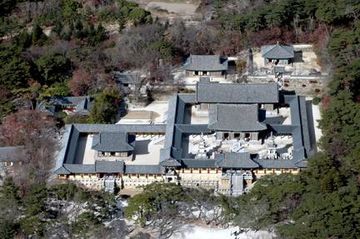경주 불국사
| 경주 불국사 Bulguksa Temple, Gyeongju |
|
 경주 불국사, 국가문화유산포털, 문화재청. |
|
| 대표명칭 | 경주 불국사 |
|---|---|
| 영문명칭 | Bulguksa Temple, Gyeongju |
| 한자 | 慶州 佛國寺 |
| 주소 | 경상북도 경주시 진현동 15-1 |
| 지정(등록) 종목 | 사적 제502호 |
| 지정(등록)일 | 2009년 12월 21일 |
| 분류 | 유적건조물 |
| 수량/면적 | 409,315㎡ |
| 웹사이트 | 경주 불국사, 국가문화유산포털, 문화재청. |
|
|
|
해설문
국문
불국사의 창건에 대해서는 삼국유사에 두 가지 설이 전한다. 하나는 김대성(金大城)이 현세의 부모를 위해 불국사를, 전생의 부모를 위해 석불사(石佛寺)를 짓고 신림(神琳), 표훈(表訓) 두 고승을 청하여 각기 머물게 했다는 설이다. 다른 하나는 경덕왕 때 재상 김대성이 751년 불국사를 짓기 시작하였지만, 혜공왕 10년(774) 그가 죽자 나라에서 이를 완성하고 유가의 대덕 항마(降魔)를 이 절에 머물게 하였다는 설이다. 고려 현종대에 작성된 불국사 「서석탑중수기」에는 경덕왕 1년(742)에 창건이 시작되었다는 기록이 전한다.
임진왜란 때 의병의 주둔지로 이용된 탓에 왜군들이 불을 질러 타버렸고, 조선후기에 대웅전 등의 건물을 재건하였다. 극락전, 자하문, 범영루 등의 일부 건물만이 그 명맥을 이어오다가 1970년대에 발굴조사 뒤 복원하여 현재의 모습을 갖추게 되었다.
지금의 불국사는 대체로 건립 당시의 모습을 간직하고 있다. 대웅전을 중심으로 하는 일곽과 금동아미타불좌상을 모신 극락전 영역, 금동비로자나불좌상을 모신 비로전 영역, 관음전 영역 등으로 구분되는데, 기록에는 그 위치를 알 수 없는 건물의 이름이 45종이나 나열되어 있어 불국사가 대규모 사찰이었음을 짐작하게 한다.
불국사의 평면은 비례와 균형을 잘 갖추고 있다. 석가탑의 단순함과 다보탑의 화려함이 만들어내는 비대칭의 대칭은 풍부한 상상력과 예술적 기량이 어우러진 신라 불교미술의 정수라 할만하다. 1995년 석굴암과 더불어 유네스코 세계문화유산으로 등재되었다.
영문
Bulguksa Temple, Gyeongju
Representing the Buddhist culture of the ancient Korean kingdom of Silla (57 BCE-935 CE) and serving as home to a number of masterpieces of Buddhist artwork, Bulguksa is one of Korea’s most renowned Buddhist temples. Bulguksa, meaning “Temple of the Buddhist Country/Land of the Buddha,” is located at the southwestern foot of Tohamsan Mountain and is around 10.5 km to the southeast of the former site of the Silla royal palace.
The Bulguksa Temple complex is very large, although records suggest it was once even larger. Today, the temple consists of the historic worship area, as well as other areas which were newly built such as the monks’ residential area, a meditation center, and a museum. The historic worship area consists of five worship halls and a lecture hall, as well as auxiliary gates, pavilions, and corridor buildings. Each worship hall is dedicated to a different buddha or bodhisattva, whose statue is enshrined in the hall. Some of these statues are designated as National Treasures. The many stone structures within the temple date to the temple’s foundation and are thus also considered valuable cultural heritages.
Although historical records conflict regarding the establishment of the temple, it is widely accepted that construction of the temple was completed during the reign of King Hyegong (r. 765-780) during the Unified Silla period (668-935). The earliest extant records say that the construction began in 741/742 to commemorate the enthronement of King Gyeongdeok (r. 741/742-765), while later records say that construction began in 751 by the prime minister Kim Dae-seong (700-774) in honor of his parents. The temple is said to have been expanded in the late 9th century and used as a royal temple until the end the Silla period. It was during this period that the most iconic structures of the temple, namely the arched stone bridges leading into the worship area and the two stone pagodas in front of Daeungjeon Hall, were built.
During the Goryeo dynasty (918-1392) and early period of the Joseon dynasty (1392-1910), the temple continued to be maintained in its original Silla-period form through minor repairs, despite lessened support from the royal court. However, during the Japanese invasion of 1592-1593, the temple was destroyed by Japanese troops, who set the place on fire as it was being used as a garrison for a Korean civilian army. The temple was repaired and rebuilt during the 17th and 18th centuries. At this time, various additions were made which reflected a more typical temple of the late Joseon period.
Around the start of the Japanese colonial period (1910-1945), the temple fell into disrepair, with its wooden buildings and stone structures beginning to collapse. Between 1918 and 1926, the Japanese authorities repaired the temple, and after Korea regained independence, the temple underwent a large scale renovation from early 1970 to June 1973 to bring it to it its current form. In December 1995, Bulguksa Temple was listed on the UNESCO World Heritage Register together with the nearby Seokguram Grotto. In the 2000s and 2010s, the two pagodas in front of Daeungjeon Hall underwent extensive surveys and were repaired.